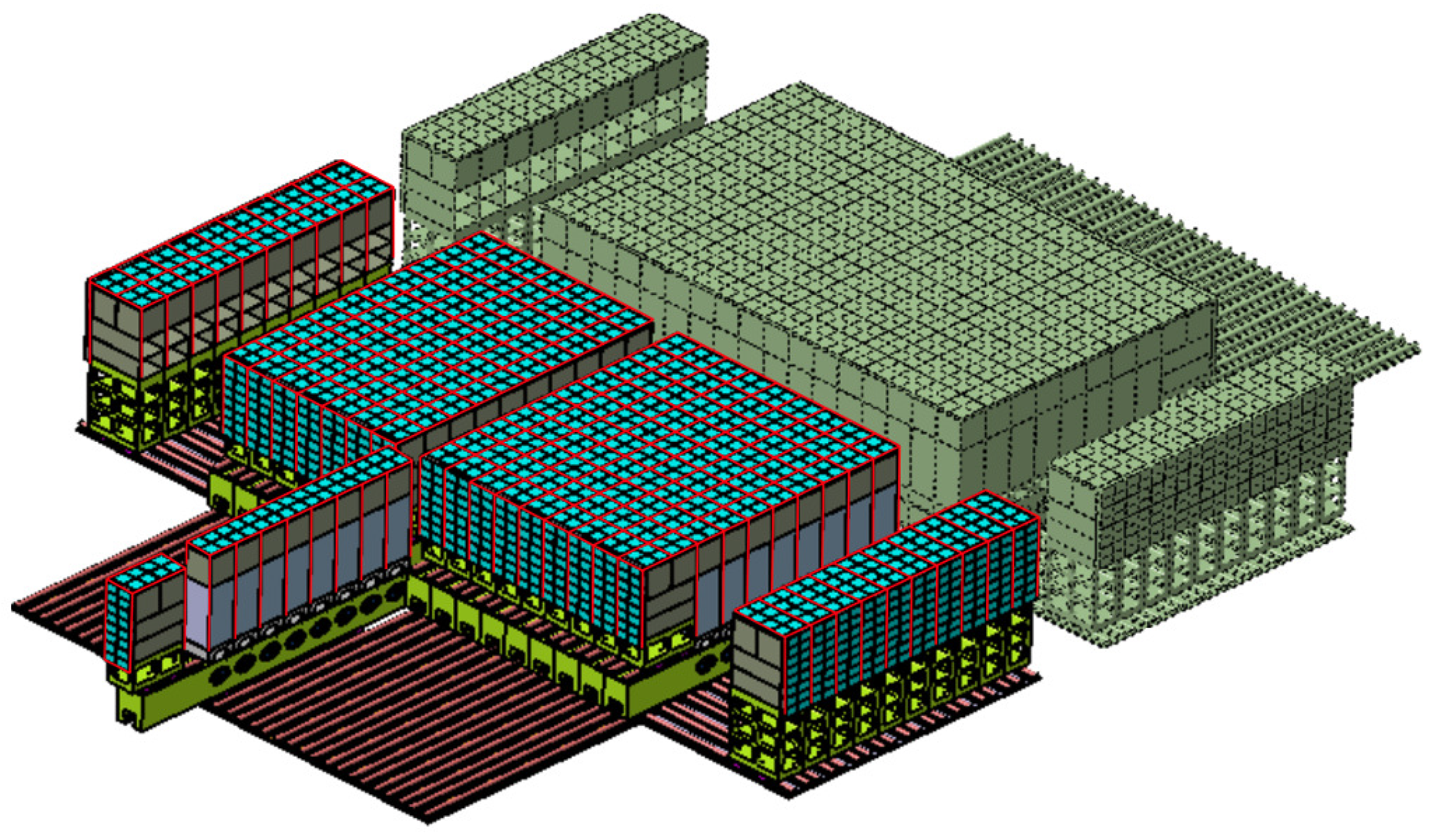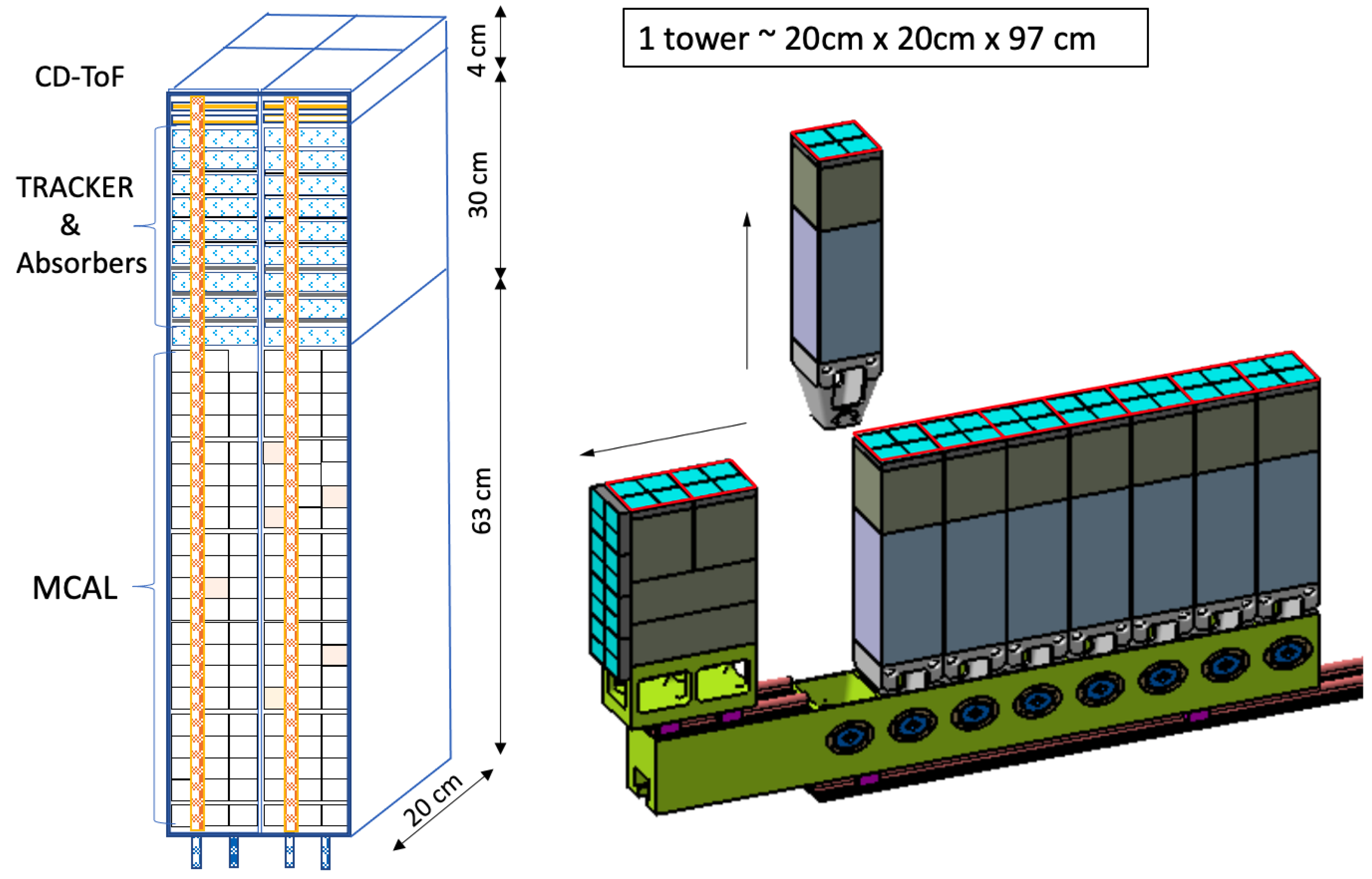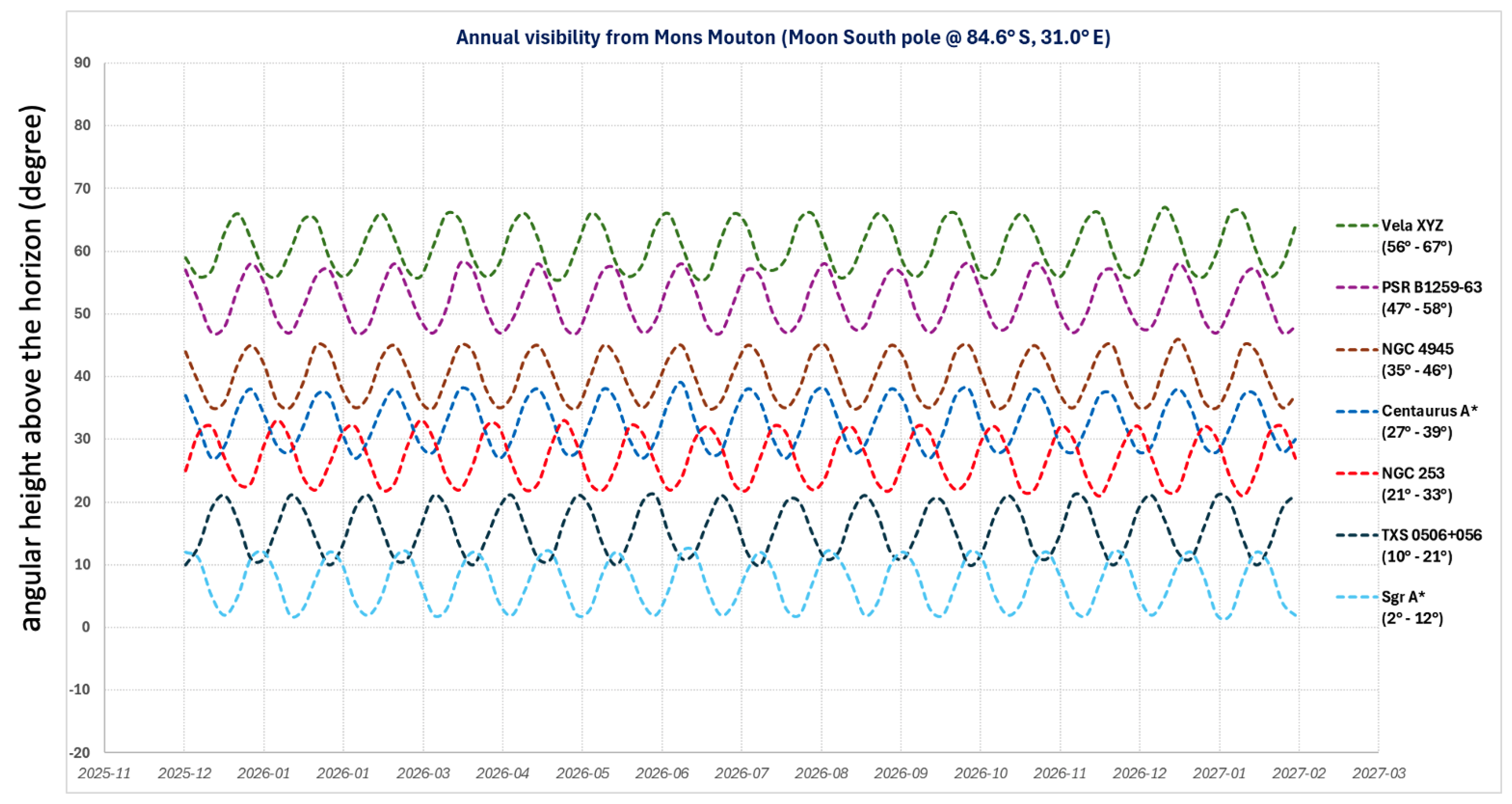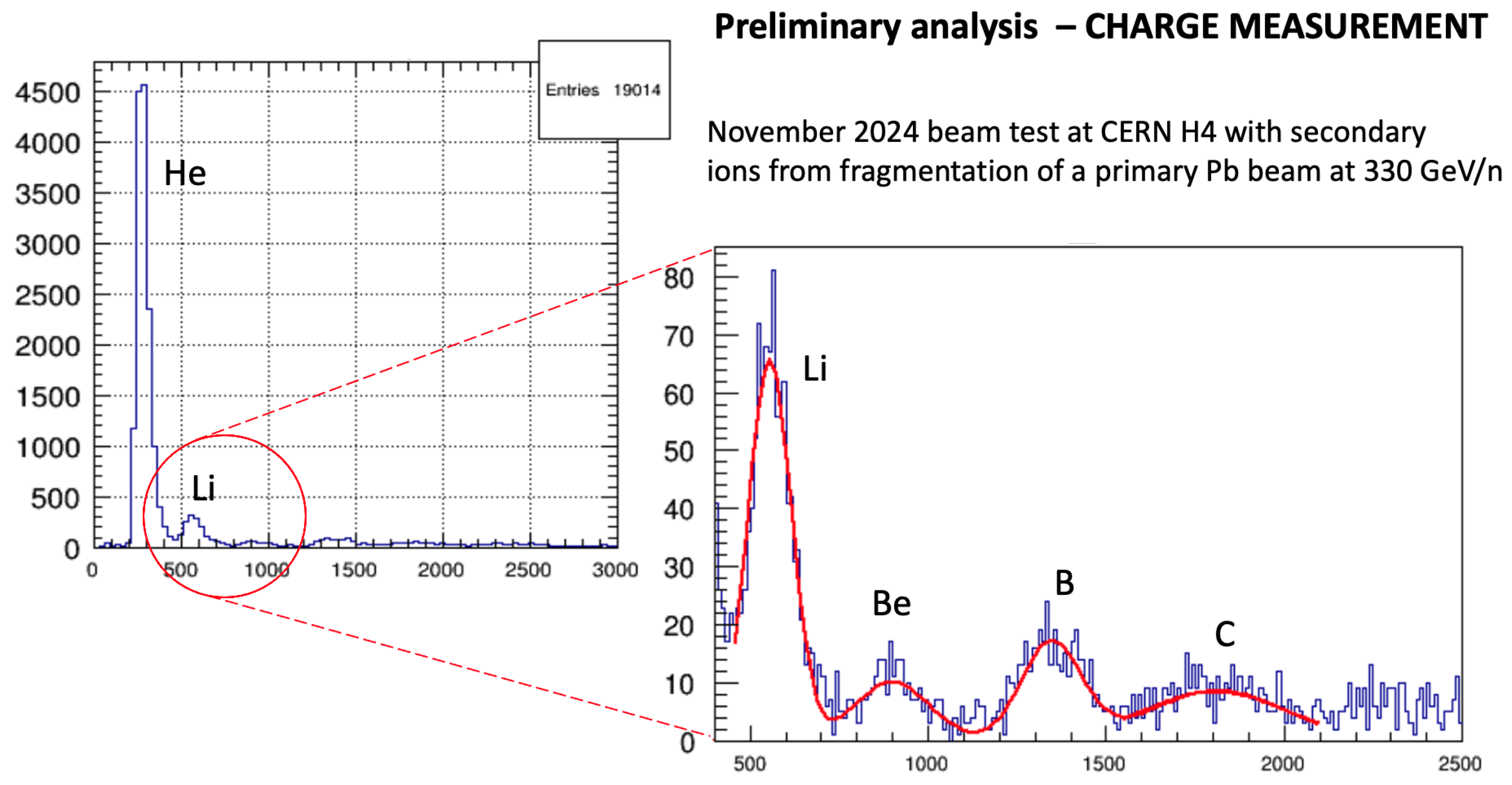A Cosmic Radiation Modular Telescope on the Moon: The MoonRay Concept
Abstract
1. Introduction
2. High-Energy Cosmic Rays
3. The MoonRay Concept
4. Outline of the MoonRay Cosmic Radiation Telescope
- A particle identifier (CD-ToF), integrating high resolution Time-of-Flight (ToF) capabilities into a charge detector (CD), for the simultaneous measurement of the electric charge and of the time of arrival of the incident particle. This is a newly developed instrument based on Low-Gain Avalanche Diode (LGAD) sensors with sub-ns time resolution. It allows a clean charge identification of the CR incident particle thanks to an efficient rejection of the copious backscattering background generated by its interaction with the calorimeter;
- A modular tracking system (MT) based on semiconductor position detectors (interspaced with thin photon absorbers) or, alternatively, on a scintillating fiber tracker with silicon photodetectors (SiPM) readout;
- A homogeneous calorimeter (MCAL) segmented in layers of reasonable size and weight, each consisting of a 3D array of scintillating crystals readout by photodiodes.
5. High-Energy Gamma Rays
6. The CD-ToF Particle Identifier
7. Development of LGAD Arrays
8. Conclusions
Funding
Data Availability Statement
Acknowledgments
Conflicts of Interest
References
- Panov, A.D.; Adams, J.H.; Ahn, H.S.; Bashindzhagyan, G.L.; Batkov, K.E.; Chang, J.; Christl, M.; Fazely, A.R.; Ganel, O.; Gunashingha, R.M.; et al. The results of ATIC-2 experiment for elemental spectra of cosmic rays. Bull. Russ. Acad. Sci. Phys. 2006, 71, 494. [Google Scholar] [CrossRef]
- Ahn, H.S.; Allison, P.; Bagliesi, M.G.; Beatty, J.J.; Bigongiari, G.; Childers, J.T.; Conklin, N.B.; Coutu, S.; DuVernois, M.A.; Ganel, O.; et al. Discrepant hardening observed in cosmic-ray elemental spectra. Astrophys. J. Lett. 2010, 714, L89. [Google Scholar] [CrossRef]
- Adriani, O.; Barbarino, G.C.; Bazilevskaya, G.A.; Bellotti, R.; Boezio, M.; Bogomolov, E.A.; Bonechi, L.; Bongi, M.; Bonvicini, V.; Borisov, S.; et al. PAMELA Measurements of Cosmic-Ray Proton and Helium Spectra. Science 2011, 332, 69. [Google Scholar] [CrossRef] [PubMed]
- Aguilar, M.; Aisa, D.; Alpat, B.; Alvino, A.; Ambrosi, G.; Andeen, K.; Arruda, L.; Attig, N.; Azzarello, P.; Bachlechner, A.; et al. Precision Measurement of the Proton Flux in Primary Cosmic Rays from Rigidity 1 GV to 1.8 TV with the Alpha Magnetic Spectrometer on the International Space Station. Phys. Rev. Lett. 2015, 114, 171103. [Google Scholar] [CrossRef] [PubMed]
- Adriani, O.; Akaike, Y.; Asano, K.; Asaoka, Y.; Bagliesi, M.G.; Berti, E.; Bigongiari, G.; Binns, W.R.; Bonechi, S.; Bongi, M.; et al. Direct Measurement of the Cosmic-Ray Proton Spectrum from 50 GeV to 10 TeV with the Calorimetric Electron Telescope on the International Space Station. Phys. Rev. Lett. 2019, 122, 181102. [Google Scholar] [CrossRef] [PubMed]
- An, Q.; Asfandiyarov, R.; Azzarello, P.; Bernardini, P.; Bi, X.J.; Cai, M.S.; Chang, J.; Chen, D.Y.; Chen, H.F.; Chen, J.L. Measurement of the cosmic ray proton spectrum from 40 GeV to 100 TeV with the DAMPE satellite. Sci. Adv. 2019, 5, eaax3793. [Google Scholar] [CrossRef] [PubMed]
- Atkin, E.; Bulatov, V.; Dorokhov, V.; Gorbunov, N.; Filippov, S.; Grebenyuk, V.; Karmanov, D.; Kovalev, I.; Kudryashov, I.; Kurganov, A.; et al. New universal cosmic-ray knee near a magnetic rigidity of 10 TV with the NUCLEON space observatory. Astrophys. Cosmol. 2018, 108, 5. [Google Scholar] [CrossRef]
- Adriani, O.; Akaike, Y.; Asano, K.; Asaoka, Y.; Berti, E.; Bigongiari, G.; Binns, W.R.; Bongi, M.; Brogi, P.; Bruno, A.; et al. Observation of Spectral Structures in the Flux of Cosmic-Ray Protons from 50 GeV to 60 TeV with the Calorimetric Electron Telescope on the International Space Station. Phys. Rev. Lett. 2022, 129, 101102. [Google Scholar] [CrossRef] [PubMed]
- Dong, Y.; Xu, M.; Wang, Z.; Adriani, O.; Albergo, S.; Ambrosi, G.; Azzarello, P.; Bai, Y.; Bao, T.; Bernardini, P.; et al. A novel 3-D calorimeter for the High-Energy cosmic-Radiation Detection (HERD) Facility onboard China’s Future Space Station. In Proceedings of the 35th International Cosmic Ray Conference—ICRC2017, Busan, Republic of Korea, 10–20 July 2017; Volume 253. [Google Scholar] [CrossRef]
- Schael, S.; Atanasyan, A.; Berdugo, J.; Bretz, T.; Czupalla, M.; Dachwald, B.; von Doetinchem, P.; Duranti, M.; Gast, H.; Karpinski, W.; et al. AMS-100: The next generation magnetic spectrometer in space—An international science platform for physics and astrophysics at Lagrange point 2. Nucl. Instrum. Methods Phys. Res. Sect. A 2019, 944, 162561. [Google Scholar] [CrossRef] [PubMed]
- Adriani, O.; Altomare, C.; Ambrosi, G.; Azzarello, P.; Barbato, F.C.T.; Battiston, R.; Baudouy, B.; Bergmann, B.; Berti, E.; Bertucci, B.; et al. Design of an Antimatter Large Acceptance Detector in Orbit (ALADInO). Instruments 2022, 6, 19. [Google Scholar] [CrossRef]
- Atwood, W.B.; Abdo, A.A.; Ackermann, M.; Althouse, W.; Anderson, B.; Axelsson, M.; Baldini, L.; Ballet, J.; Band, D.L.; Barbiellini, G.; et al. The large area telescope on the Fermi gamma-ray space telescope mission. Astrophys. J. 2009, 697, 2. [Google Scholar] [CrossRef]
- Marrocchesi, P.S. MOONRAY: A permanent high-energy cosmic-ray observatory on the surface of the Moon. Astropart. Phys. 2023, 152, 102879. [Google Scholar] [CrossRef]
- Cartiglia, N.; Arcidiacono, R.; Baldassarri, B.; Boscardin, M.; Cenna, F.; Dellacasa, G.; Dalla Betta, G.F.; Ferrero, M.; Fadeyev, V.; Galloway, Z.; et al. Tracking in 4 dimensions. Nucl. Instrum. Methods Phys. Res. Sect. A 2017, 845, 47–51. [Google Scholar] [CrossRef]
- Giacomini, G. Fabrication of Silicon Sensors Based on Low-Gain Avalanche Diodes. Front. Phys. 2021, 9, 618621. [Google Scholar] [CrossRef]
- Brogi, P.; Bigongiari, G.; Bisht, A.; Boscardin, M.; Bossini, E.; Vignali, M.C.; Collazuol, G.; Dalla Betta, G.F.; Giroletti, S.; Maestro, P.; et al. Beam test preliminary results of the ADA-5D LGADs Detectors and Front-End electronics. J. Instrum. 2025, 20, C08032. [Google Scholar] [CrossRef]





| Tiles | m2 | GFeff (m2sr) Proton (55) | GFeff (m2sr) Electron (30) |
|---|---|---|---|
| Top-Down | 3.2 × 3.2 | 11.3 | 12.1 |
| Lateral | 3.2 × 0.7 | 3.5 | 3.8 |
| Total | 14.8 | 15.9 |
| Tiles | SSD Tiles | Areaeff (m2) |
|---|---|---|
| Top-Down | 1024 | 3.3 |
| Lateral | 4 × 128 | 2.6 |
| Corner | 4 × 128 | 1.6 |
| Total | 2048 | 7.5 |
Disclaimer/Publisher’s Note: The statements, opinions and data contained in all publications are solely those of the individual author(s) and contributor(s) and not of MDPI and/or the editor(s). MDPI and/or the editor(s) disclaim responsibility for any injury to people or property resulting from any ideas, methods, instructions or products referred to in the content. |
© 2025 by the author. Licensee MDPI, Basel, Switzerland. This article is an open access article distributed under the terms and conditions of the Creative Commons Attribution (CC BY) license (https://creativecommons.org/licenses/by/4.0/).
Share and Cite
Marrocchesi, P.S. A Cosmic Radiation Modular Telescope on the Moon: The MoonRay Concept. Particles 2025, 8, 86. https://doi.org/10.3390/particles8040086
Marrocchesi PS. A Cosmic Radiation Modular Telescope on the Moon: The MoonRay Concept. Particles. 2025; 8(4):86. https://doi.org/10.3390/particles8040086
Chicago/Turabian StyleMarrocchesi, Pier Simone. 2025. "A Cosmic Radiation Modular Telescope on the Moon: The MoonRay Concept" Particles 8, no. 4: 86. https://doi.org/10.3390/particles8040086
APA StyleMarrocchesi, P. S. (2025). A Cosmic Radiation Modular Telescope on the Moon: The MoonRay Concept. Particles, 8(4), 86. https://doi.org/10.3390/particles8040086








